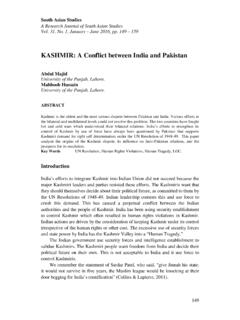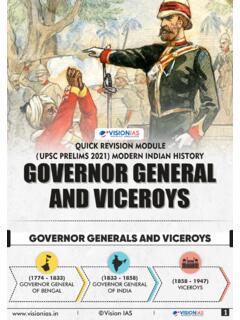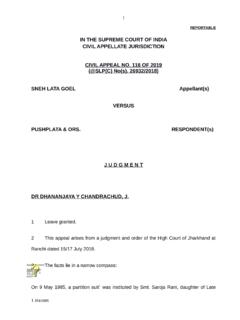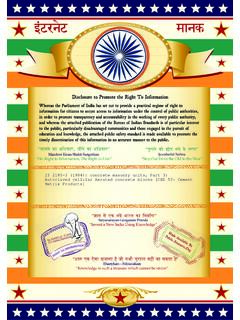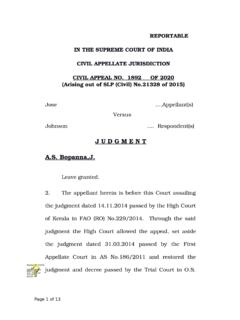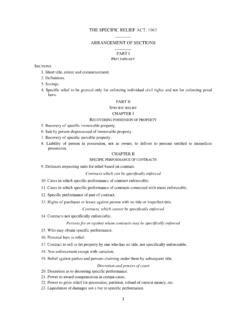Transcription of Final Chapter 2 - NCERT
1 Federalism13 Chapter 2 FederalismOverviewIn the previous Chapter , we noted that vertical division of power amongdifferent levels of government is one of the major forms of power-sharing in modern democracies. In this Chapter , we focus on this formof power-sharing. It is most commonly referred to as federalism. Webegin by describing federalism in general terms. The rest of the chaptertries to understand the theory and practice of federalism in india . Adiscussion of the federal constitutional provisions is followed by ananalysis of the policies and politics that has strengthened federalism inpractice.
2 Towards the end of the Chapter , we turn to the localgovernment, a new and third tier of Indian 2214 Democratic PoliticsWhat is federalism?Let us get back to the contrast betweenBelgium and Sri Lanka that we saw inthe last Chapter . You would recall thatone of the key changes made in theConstitution of Belgium was to reducethe power of the Central Governmentand to give these powers to the regionalgovernments. Regional governmentsexisted in Belgium even earlier. Theyhad their roles and powers. But all thesepowers were given to thesegovernments and could be withdrawnby the Central Government.
3 Thechange that took place in 1993 was thatthe regional governments were givenconstitutional powers that were nolonger dependent on the centralgovernment. Thus, Belgium shiftedfrom a unitary to a federal form ofgovernment. Sri Lanka continues to be,for all practical purposes, a unitarysystem where the national governmenthas all the powers. Tamil leaders wantSri Lanka to become a federal is a system ofgovernment in which the power isdivided between a central authority andvarious constituent units of thecountry.
4 Usually, a federation has twolevels of government. One is thegovernment for the entire country thatis usually responsible for a few subjectsof common national interest. Theothers are governments at the level ofprovinces or states that look aftermuch of the day-to-day administeringof their state. Both these levels ofgovernments enjoy their powerindependent of the am do we callthe Indiangovernment? Isit Union, Federalor Central?Though only 25 of the world s 193 countries have federal political systems, their citizens make up 40 per cent of theworld s population.
5 Most of the large countries of the world are federations. Can you notice an exception to this rulein this map?Source: Montreal and Kingston, Handbook of Federal Countries: 2002, McGill-Queen s University Press, systemsCanadaUnited Statesof AmericaMexicoPACIFIC OCEANM icronesiaArgentinaVenezuelaATLANTICOCEAN B razilSt. Kittsand NevisBelgiumSwitzerlandSpainNigeriaEthio piaComorosBosnia andHerzegovinaAustriaPakistanRussiaIndia MalaysiaAustraliaINDIANOCEANS outh AfricaPACIFIC OCEANU nitedArabEmiratesGermany2021 22 Federalism15 Jurisdiction: T he areaov er which someonehas legal authority.
6 Thearea may be defined interms of geographicalboundaries or in termsof certain kinds federal system thus has dualobjectives: to safeguard and promoteunity of the country, while at the sametime accommodate regional , two aspects are crucial forthe institutions and practice offederalism. Governments at differentlevels should agree to some rules ofpower-sharing. T hey should also trustthat each would abide by its part ofthe agr eement. An ideal federal systemhas both aspects : mutual trust andagreement to live exact balance of powerbetween the central and the stategovernment varies from one federationto another.
7 This balance dependsmainly on the historical context in whichthe federation was formed. There aretwo kinds of routes through whichfederations have been formed. T he firstroute involves independent Statescoming together on their own to forma bigger unit, so that by poolingsovereignty and retaining identity theycan increase their security. This type of coming together federations includethe USA, Switzerland and Australia. Inthis first category of federations, all theconstituent States usually have equalpower and are strong vis- -vis thefederal gov second route is where a largecountry decides to divide its powerbetween the constituent States and thenational gov ernment.
8 india , Spain andBelgium are examples of this kind of holding together federations. Inthis second category, the centralgovernment tends to be more powerfulvis- -vis the States. V ery often differentconstituent units of the federation haveunequal powers. Some units aregr anted special federalismworks only in bigcountries, whydid Belgiumadopt it?In this sense, federations arecontrasted with unitary gov the unitary system, either thereis only one level of government or thesub-units are subordinate to the centralgov ernment.
9 The central gov ernmentcan pass on orders to the provincial orthe local gov ernment. But in a federalsystem, the central gov ernment cannotorder the state government to dosomething. State government haspowers of its own for which it is notanswerab le to the central gov these gov ernments are separatelyanswerab le to the us look at some of the keyfeatures of federalism :1 There are two or more levels (ortiers) of gov tiers of governmentgo vern the same citizens, but each tierhas its own JURISDICTION in specificmatters of legislation, taxation jurisdictions of the respectivelevels or tiers of government arespecified in the constitution.
10 So theexistence and authority of each tier ofgovernment is fundamental provisions ofthe constitution cannot be unilaterallychanged by one level of gov changes require the consent ofboth the levels of have the power to interpretthe constitution and the powers ofdifferent levels of government. Thehighest court acts as an umpire ifdisputes arise between different levelsof gov ernment in the exercise of theirrespective of rev enue for each levelof gov ernment are clearly specified toensure its financial 2216 Democratic PoliticsIsn t thatstrange?










